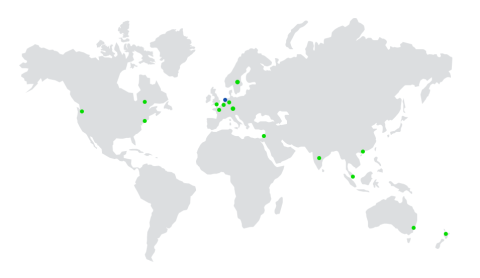
Table of Contents
- What is Space Management?
- The importance of effective space management
- Benefits of using space management software
- The evolution of space management
- The need for space management in the future
What is Space Management?
Space management is the management of an organization’s physical space inventory. This involves tracking how much space an organization has, managing occupancy information, and creating spatial plans. Managing your office space is key to encouraging employees to return to the workplace and feel happy once they’re there.
The importance of effective space management
Having a clear understanding of spaces and their usage is a critical component of effective facility management, as it is the foundation for many other activities, such as: occupancy management, move management, room reservations, maintenance management and property management.
Benefits of using space management software
Using innovative space management software to successfully manage an organization’s space offers a number of benefits. For example:
1. The ability to identify space and lower portfolio costs
One of the largest expenses for an organization is made up of personnel and accommodation costs. Effective space management has a direct impact on both cost centers, making it a critical component that can greatly impact the bottom line of the business.
Ideally, an organization would use every inch of their space for the intended purpose, whether it be meeting rooms, storage, labs, desks, or dining space. Using space management software provides the accurate and real-time data that is needed to see if spaces could be used more effectively to reduce costs.
This means that organizations can re-allocate spaces that aren’t being used for a more appropriate purpose or even make a case for, or against, the need for an expansion based upon real-time data. An organization with a space team that is equipped with real-time, accurate data, can make better decisions that will drastically cut portfolio costs.
2. Create a pleasant working environment and improve productivity
There’s always a need to have the right people with the right skills into the right roles – the War for Talent – is higher than ever before. The focus of space management is shifting from just reducing space costs toward also creating a working environment that helps to attract and retain talented employees. This doesn’t mean that reducing space costs is no longer high on the priority list of Facility and Space Managers, but finding the right balance is becoming more important.
In order for employees to remain satisfied and engaged, Facility and Space Managers need to provide employees with workspaces that meet their needs. This means providing enough physical space to be able to complete daily tasks in a comfortable and effective way, but not so much that the organization pays for space that is not needed. Space Managers have started to explore how to provide different kinds of spaces for different purposes, for example, silent rooms for employees who do not need to be disturbed, or creative spaces with comfortable chairs that encourage employees to brainstorm, innovate, and collaborate with others in a less formal setting.
46% of the real estate and facilites directors rate improving occupant comfort as a top priority in the near future.
~Verdantix
3. Generate reports to develop strategic space plans
Without software for space management in place, it becomes difficult and time consuming to run reports on real-time and accurate space data as the data is simply not centralized in one system. Additionally, when space data is spread out and stored at different locations, redundancies can occur, making it more difficult to know which dataset is more up to date. An innovative software solution for space management, ideally integrated into an Integrated Workplace Management System (IWMS), centralizes all data into one system, collecting it automatically in real-time. With a space management module and IWMS in place, Facility and Space Managers can run reports such as chargeback reports and utilization reports and use scenario planning for future space allocation. Based on these reports, Facility and Space Managers are able to monitor and analyze their space management data and plan for future improvement.
While there are some excellent space management point solutions in the market, organizations will get the most out of their space management when combining it with an IWMS solution. With an IWMS, organizations can consolidate all their separate, fragmented sets of data for maintenance management, property and lease management, services management and sustainability management. This allows all stakeholders to work together better, allowing each to see accurate, up-to-date data that can aid in decision making across all participating departments.
Text continues below
Learn more about Space Management

Why effective space management is fundamental to a successful working experience
This e-book discusses the concept of space itself, describes the importance of creating an optimal working experience, and explains which elements of space management contribute to offering a successful working experience.
Read more
Effective space management: key elements to consider
In this co-hosted webinar, Verdantix addresses the importance of space management and Planon discusses key elements and provides practical examples of how facility managers can make their space management practices more effective. 49:42 English
Read more
Planon Space & Workplace Services Management
By providing visibility into the distribution and occupation density of all space, Planon’s Space & Workplace Services Management solution enables your organization to reduce costs by ensuring the proper utilization of all space, and actually matching space utilization with departmental demands.
Read moreThe evolution of space management
Space management strategy has developed considerably over the years, but many organizations still battle with how to utilize their available space in the best ways to maximize occupancy while still providing a comfortable and efficient environment for employees to get their work done. While there are still many organizations who do not have tools or solutions in place to manage their challenges with space utilization, there are many innovative solutions available today.
Space management typically falls under the facility management category, which started in the 1970s and mainly focused on reactive cleaning and maintenance. There were no tools or solutions to measure occupancy or test to see if space was being used in efficient ways. However, the priorities of companies and the expectations of employees were also different. Having the biggest office on the most popular block is not always the primary goal now. Throughout the 1990s and 2000s, space planning and reallocation strategy became more and more important. And today, organizations are trying to find new ways to downsize or better utilize their space to be as cost effective and productive as possible.
The need for space management in the future
However, even with the many options for space management solutions out there today, there are still many organizations that try to manage their space manually. Using, pen and paper diagrams that show the floor layout and room occupants, or an Excel sheet that contains the details about each individual space including occupants and resource usage can get unorganized and confusing. This manual practice also makes it extremely challenging to maintain accurate records, share accurate and real-time data – especially if the space manager or excel file owner retires. In addition, it’s very hard to use these manual reports to analyze space data to make strategic decisions to support the organization’s changing business needs.
Organizations are also faced with never-ending initiatives to cut costs, improve process efficiency, and increase productivity, and they are realizing that these manual methods of space management are not future-proof or agile enough to cope with a fast-changing space portfolio. Therefore, more and more Facility and Space Managers are starting to seriously consider investing in intelligent software solutions, such as an Integrated Workplace Management System (IWMS) to coordinate the management of spaces.

Interested in our space management solutions?
Global success stories

BayWa - Hybrid working thanks to the Planon Workplace App
Case study on using the Planon Workplace App at BayWa to support hybrid working.
Explore now
Digitization of former Berlin airport aided by Planon & Disruptive Technologies
Case study on the digitalization of Tegel Projekt GmbH's building operations using sensors and IWMS.
Explore now
Bayer Corporate Real Estate & Hexagon
This case study shows how a digital twin of rooms and facilities was integrated into Bayer Corporate Real Estate’s Planon IWMS solution. This was done in collaboration with Hexagon in order to further digitalize and optimize CREM & FM processes.
Explore now






















